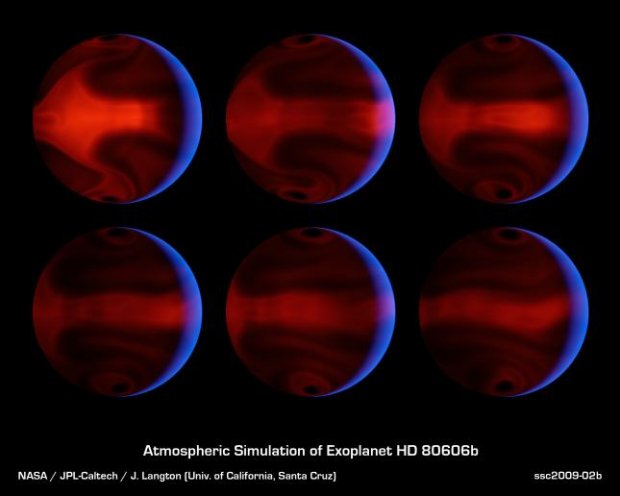
Posted on Saturday, January 31 2009 @ 9:36 CET by Thomas De Maesschalck
Astronomers have detected a new gas giant that orbits a star 190 light years from Earth. The planet has an unusual orbit that takes it as far out as 127 million kilometers from its star, and as close in as just 4.5 million kilometers. The planet is named HD 80606b and it has very wild temperature swings, researchers monitoring the planet using the Spitzer Space Telescope measured the planet's temperature rose from 800 to 1,500 Kelvin in just six hours. More details
at NASA.
The "hot-headed" planet is HD 80606b, a gas giant that orbits a star 190 light-years from Earth. It was already known to be quite unusual, with an orbit shuttling it nearly as far out as Earth is from our sun, and much closer in than our planet Mercury. Astronomers used Spitzer, an infrared observatory, to measure heat emanating from the planet as it whipped behind and close to its star. In just six hours, the planet's temperature rose from 800 to 1,500 Kelvin (980 to 2,240 degrees Fahrenheit).
"We watched the development of one of the fiercest storms in the galaxy," said astronomer Greg Laughlin of the Lick Observatory, University of California at Santa Cruz. "This is the first time that we've detected weather changes in real time on a planet outside our solar system." Laughlin is lead author of a new report about the discovery appearing in the Jan. 29 issue of Nature.
HD 80606b was originally discovered in 2001 by a Swiss planet-hunting team led by Dominique Naef of the Geneva Observatory in Switzerland. Using a method known as the Doppler-velocity technique, the astronomers learned that the planet is wildly eccentric, with an orbit more like a comet's than a planet's. HD 80606b's orbit takes it as far out as 0.85 astronomical units from its star, and as close in as 0.03 astronomical units (one astronomical unit is the distance between Earth and the sun).
The planet takes about 111 days to circle its star, but it spends most of its time at farther distances while zipping through the closest part of its orbit in less than a day. (This is a consequence of Kepler's Second Law of Planetary Motion, which states that orbiting bodies -- planets and comets -- sweep out an equal area in equal time.)
"If you could float above the clouds of this planet, you'd see its sun growing larger and larger at faster and faster rates, increasing in brightness by almost a factor of 1,000," said Laughlin.

